Chinese Cooking Methods
Chinese cuisine enjoys high fame throughout the world. Not only does it have a reputation of being delicious, it is also considered an art form in its own right. Chinese cooking involves looking at the combination of the ingredients as well as paying particular attention to the complex process and equipment involved. Different ingredients are cooked using different methods, while the same ingredient can be used in different dishes to provide different flavors and appearances. There are hundreds of cooking methods in China. However, the most common methods are stir-frying, deep-frying, shallow-frying, braising, boiling, steaming and roasting.
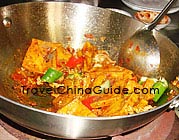
![]() Stir-frying
Stir-frying
The most frequently used method is stir-frying. This methods cooks processed ingredients at high heat for a short period of time. Edible oil is used as the heat conductor. Usually, a wok is used at high heat, edible oil is added followed by ingredients and seasonings. Due to the short period of time involved in the process, ingredients largely keep their nutritional value. Stir-fried meat is typically juicy and tasty, and vegetables are usually tender and crispy.
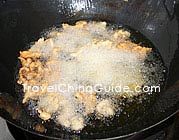
![]() Deep-frying
Deep-frying
Deep-frying uses much more edible oil than stir-frying (the ingredient should be fully submerged in the oil), producing crisp-textured food. The common method of preparing deep-frying dishes is to cut the ingredients into medium-sized pieces or chunks, soak them in prepared seasoning for a while, coat with cornstarch (optional), and finally fry in hot deep oil over medium heat. The density of coating will determine the levels of crispness and tenderness on the inside and outside of the ingredients used.
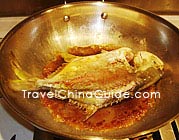
![]() Shallow-frying
Shallow-frying
As the name implies, shallow-frying is a cooking methods using less edible oil than deep-frying and lower heat than stir-frying. Shallow-fried dishes are usually rather tender inside, appearing golden or slightly burnt outside. The ingredients for shallow-frying are usually cut into slices or flat pieces and rubbed with seasonings. To make the outer skin crispy, the ingredients are also slightly coated with cornstarch after being seasoned. When cooking, the ingredients should be shallow-fried on one side first and then turned to the other.
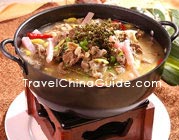
![]() Braising
Braising
To cook large-sized ingredients melt-in-your-mouth, braising is to add ingredients and seasonings in a wok or a saucepan at the same time, add in some water, boil it and then simmer it for one hour or more. The ingredients are usually cut into cubes or diamonds. To cook dishes by braising, the ingredients especially the animal ingredients should be get rid of the fishy smell in boiling water and rinsed in clean water first, and the sauce is thickened either with cornstarch or reduced by simmering finally.
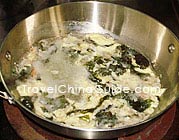
![]() Boiling
Boiling
Boiling could be considered the simplest among all the Chinese cooking methods. It simply involves placing food in boiling water. It is mainly used for cooking small-sized and soft ingredients, especially for most of the vegetable soups like Tomato and Egg Soup and Tofu Soup. Prepared ingredients are placed into a wok, along with water and appropriate seasonings when the surface of the water is continually agitated by large bubbles. Dishes cooked by boiling always taste fresh and clear, for it takes a shorter time than braising.
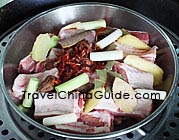
![]() Steaming
Steaming
A special cooking method invented in China is steaming. It is widely used for steaming buns and dumplings in northern China, where people live on wheaten food. The process involves placing the ingredients in a steamer basket which is placed over water in a steamer pot. Steamed food contains more nutrition than that of boiled for less nutrition is leached into the water. Very little edible oil and fewer seasonings are used (most Chinese just steam beaten egg only with salt), so the food’s natural flavor is maintained and even enhanced.
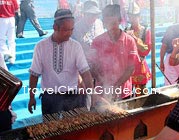
![]() Roasting
Roasting
Roasting is to cook the food over the open flame of charcoal or in an oven. The moisture of the food is removed whilst seasonings rubbed in from the outside. The outside of the roasted foods always gets drier and browned, but flavors are retained and enhanced. Many ingredients can be roasted, including all kinds of meat along with most root and bulb vegetables. To roast food, the ingredients must be cleaned, seasoned and basted with edible oil in order to reduce the loss of moisture in the ingredients during the roasting process.